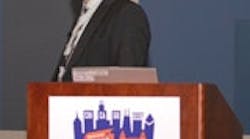Industrial machine builders face daunting challenges when they expand into new markets. To achieve success theyre required to deliver high-performance machines faster, while adapting to regional conditions and growing customer demand for integration.
Todays machines can generate huge amounts of data, and new business realities such as time-to-market pressures and regulatory compliance are driving many original equipment manufacturers (OEMs) to build machines with integrated control and information systems. These machines must easily and cost-effectively integrate together within an end users operation as well as connect to the business information system. Creating an integrated environment where information can be accessed easily from the automation system and viewed in the correct context enables better, faster decision-making.
The Global Machine Builders Industry Forum, held this morning at Rockwell Automations Automation Fair 2007 in Chicago, covered some of the critical performance and global market issues impacting manufacturing success in China and later pointed out key ways to let standards help deliver innovative solutions to customers.
China forces us to rapidly develop efficient, integrated and fully communicating systems. TetraPaks Laurence Mott on the increasing level of automation sophistication required of machine builders serving the Chinese market.
Motts presentation focused on a timely subject: building machines and doing business in the ultra-fast-moving Chinese marketplace. Our top customer in the world is in China and it didnt exist in 1998, said Mott.
Mott offered several learned lessons that must be adhered to in order to build and sell machines in China. You must source machine components locally in high volumes, you must adjust rapidly for newer, more modern product requirements--some of which are subject to rapid updates in policies and regulations, he said.
Mott says China is very efficient in export logistics but, not surprisingly, is largely inefficient regarding imports, so youd better be manufacturing there. He also forewarned that the turnover of talented people is incredibly high.
Mott pointed out that the Chinese user market requires unprecedented levels of machine integration compared with Europe and North America. We made individual machines, but only recently began serious thinking about this level of seamless integration for package flow, he said. China forces us to rapidly develop great, efficient, and integrated, fully communicating systems.
Contrary to what many think, Chinese manufacturers are out to reduce operator dependency, perhaps more than other world regions, said Mott. Our customers are insisting on completely new levels of functionality, traceability, and advanced marking for primary and secondary packaging, he said. Our machines are becoming more customized, and going into showcase facilities, where high-performance is demanded, and where the trend is toward low predictability about what will be required from us later.
Global End User Needs
Mike Lamping, P.E, is an engineering technology leader for Procter & Gamble. With more than 25 years of disposable consumer goods manufacturing experience, Lamping currently is chair of the PackML group within the Open Modular Architecture Controls (ISA/OMAC) Users Group, and is an active member of the Make2Pack standardization effort.
Providing an end user perspective, Lamping says Procter & Gamble feels pressures for lower total cost of ownership and higher volumes that drive the demand for higher capability. Machines that enable lower mean-time-before-failure (MTBF) and mean-time-to-repair (MTTR), as well as higher speeds and production coordination, are critical in optimizing output.
Lamping talked about the need for information-enabled machines from its builders. Data isnt information, and effective management and machine utilization needs real information, he said. Continuous improvement requires relevant information.
Lamping believes innovation from its OEMs drives profits up. We want to encourage innovation, he stressed. But he also stresses that non-standard machinery is a problem. Having different, unique machines raises costs, increases training needs and slows knowledge acquisition.
That led Lamping to stress the importance of standards in ensuring good information, particularly adhering to ISA 88 and in particular OMACs PackML as a means to drive operations standards and a standard construct for every machine largely based on the state model method.
Theres big benefit in just having one state model to learn, said Lamping. Its independent of time and technology and is reusable code. It provides a procedure for common tag naming, and as a result time to install and integrate machines improves, uptime is maximized because of a common method.
Lamping also stated that the investment in learning and application time and cost lessens each time its deployed.
Lamping closed by explaining that P&G is actively putting the state model practices and programming in place, with the goal of it being an integral part of every global business unit. In fact, said Lamping, P&Gs Beauty Care business unit now requires OEMs to comply with OMAC version 3 state model standards in its bid package.




